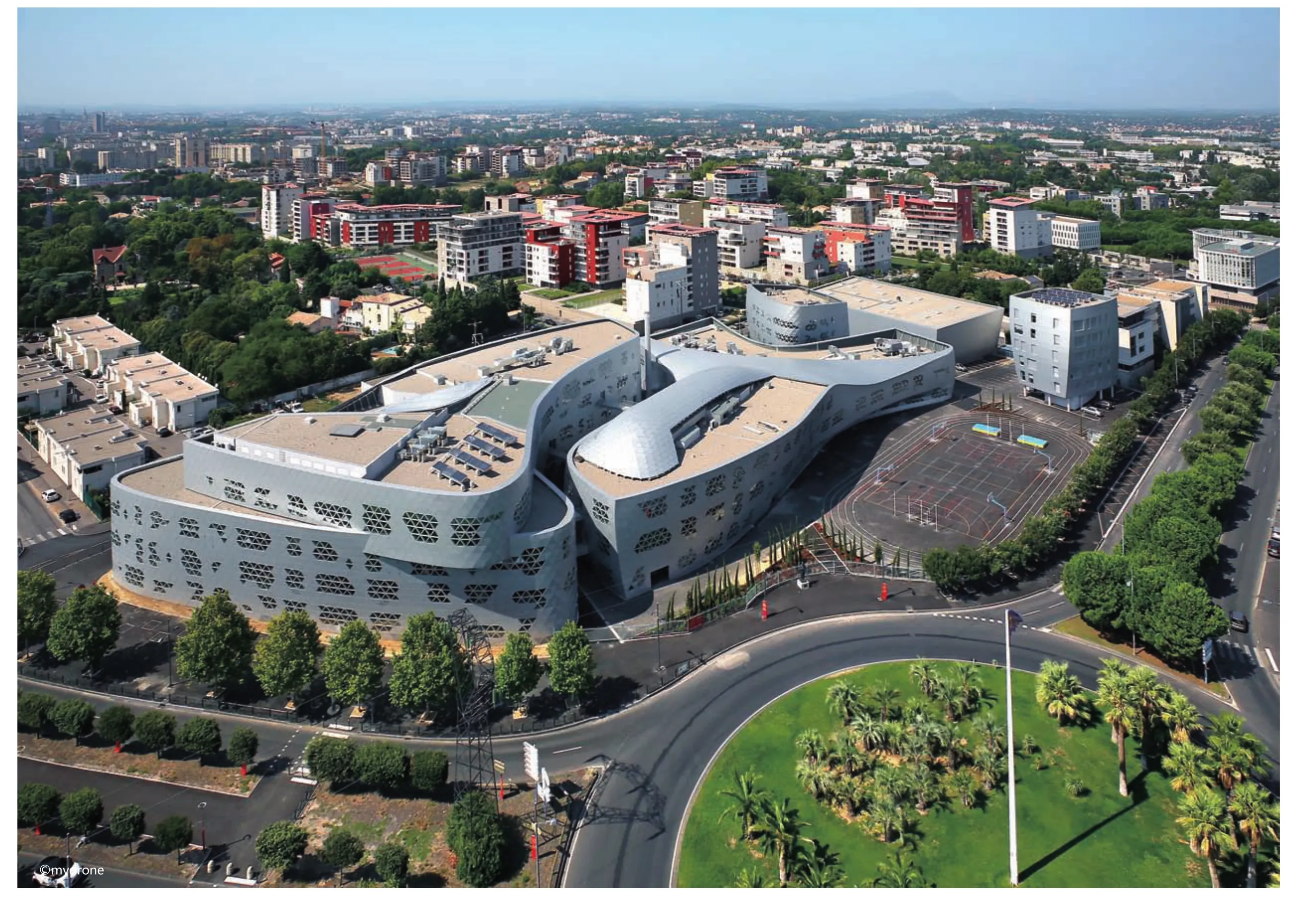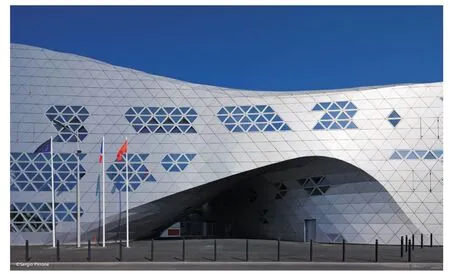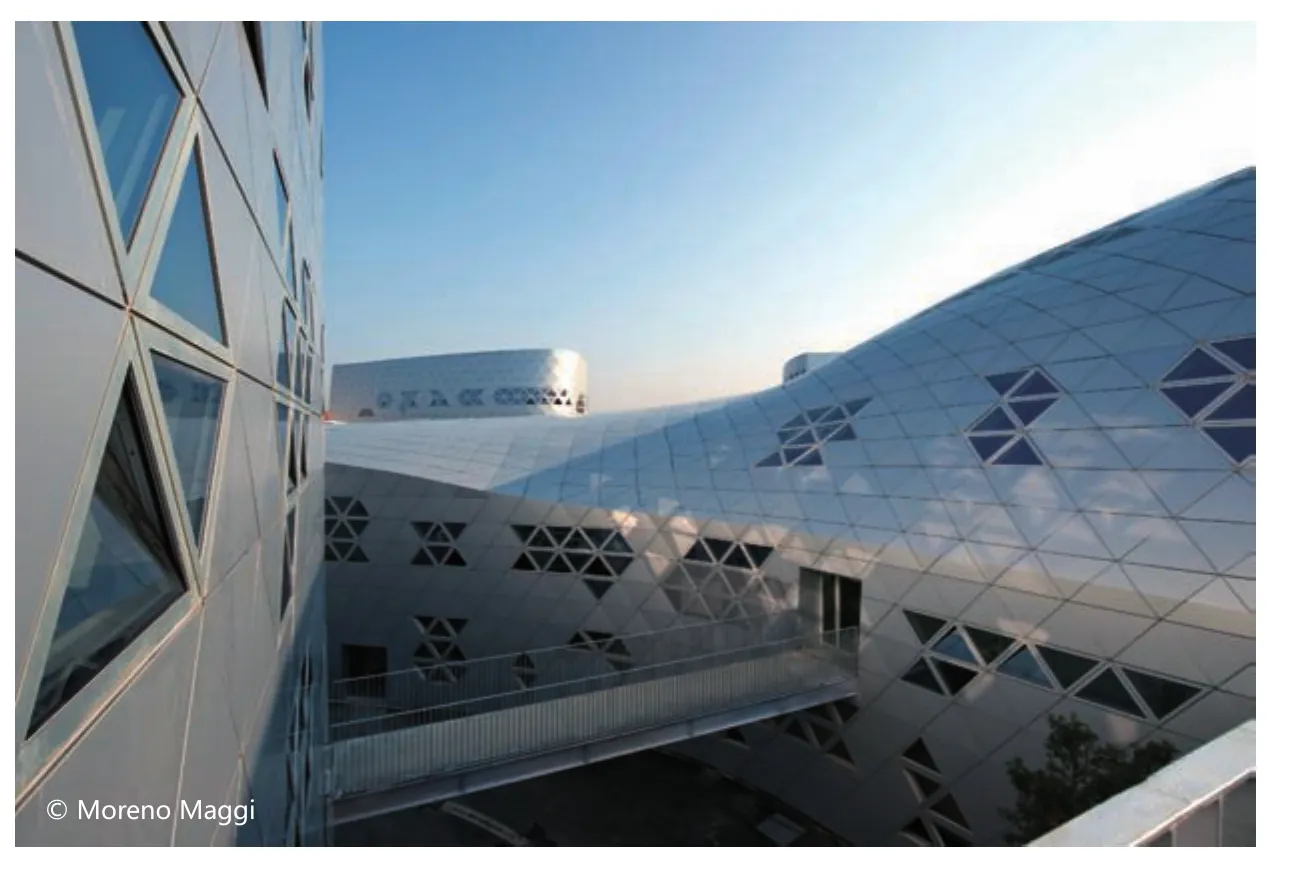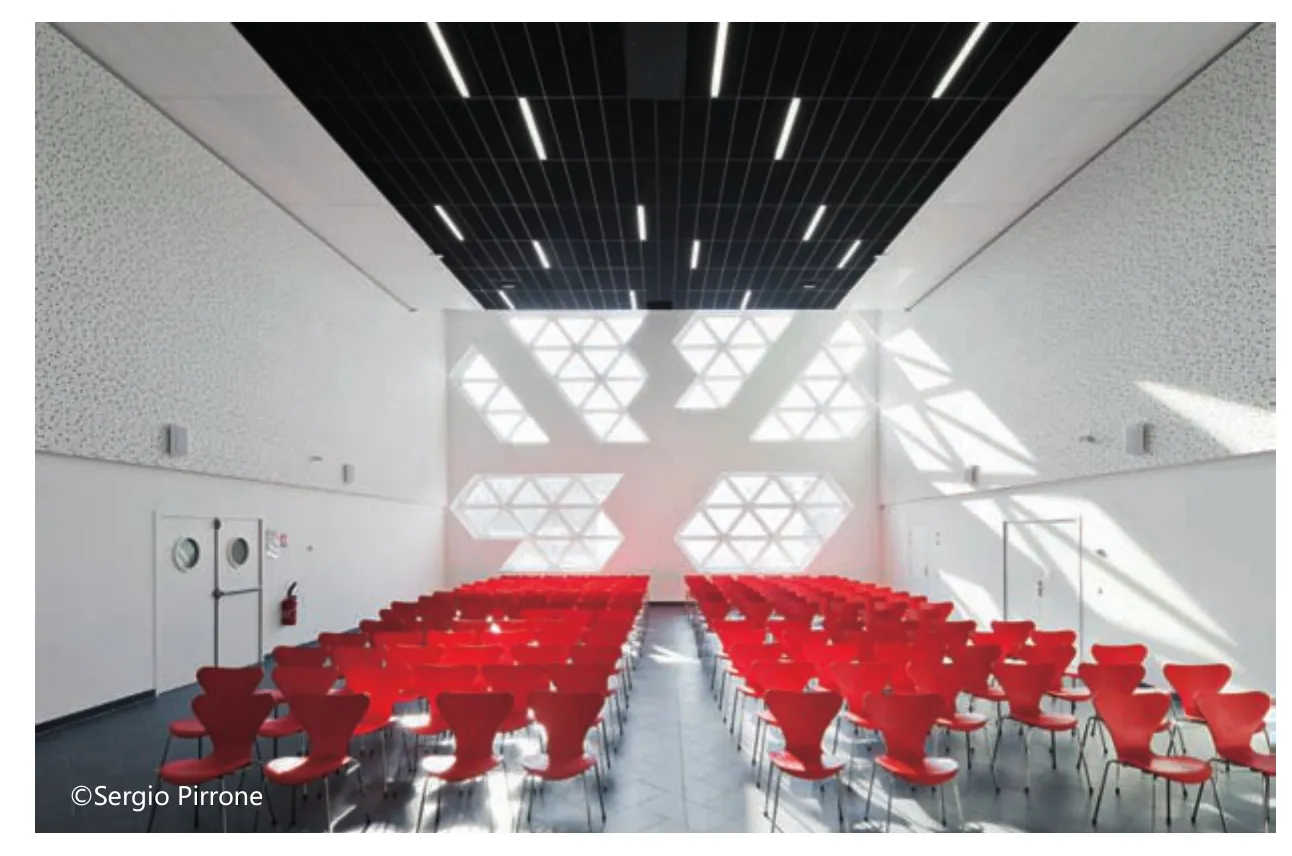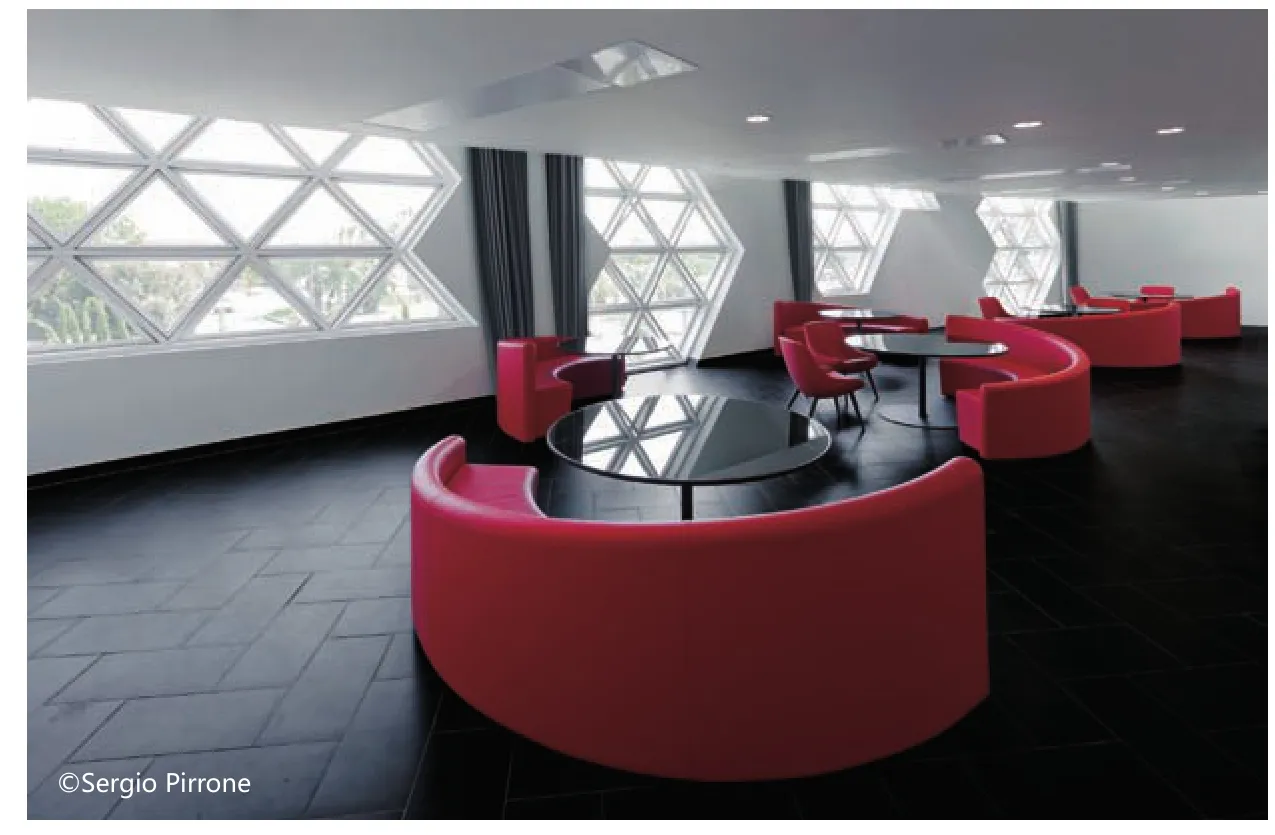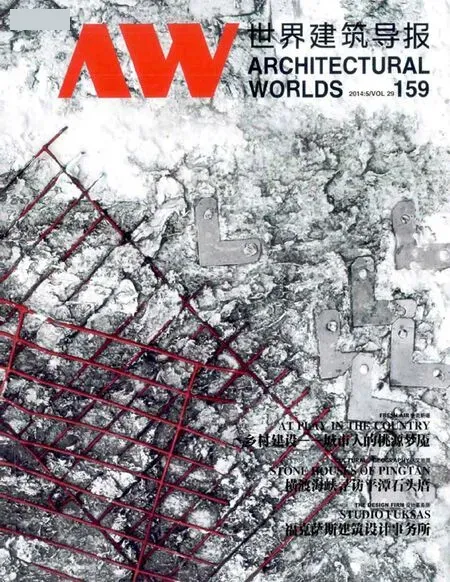乔治思-弗雷切酒店管理学院
地点:法国蒙彼利埃
时间:2007年-2012年,设计竞赛2007年
业主:Région Languedoc-Roussillon
建筑师:马希米亚诺•福克萨斯,多丽安娜•福克萨斯
表面面积:净表面积-23,600平方米;总表面积-25,736.80平方
米;建筑面积:16,500平方米
SITE: 401, rue le Titien 34000 Montpellier, France
PERIOD: 2007-2012, competition 2007
CLIENT: Région Languedoc-Roussillon
ARCHITECTS: Massimiliano and Doriana Fuksas
SURFACES: Net surface: 23,600 sq.m.; Gross surface: 25,736.80 sq.m.;
Area surface: 16,500 sq.m.
建于蒙彼利埃扎克玛丽安港地区、占地面积3.95英亩的乔治思-弗雷切酒店管理学院改变了当地的风光,赋予了那里明显的都市特征。
福克萨斯建筑事务所平地而起的工程,看起来就像一个独立体。它形式多样、体量小巧,形如雕塑。即便是在建筑物内部,体形上的复杂性也依然可见,这赋予了每个房间各不相同的空间特性。学院设有:
• 两座主楼,以一条人行桥连接,该桥与种在庭院中心的树相互交错
• 学生宿舍(75个床位,分布在三个楼层)
• 管理人员住宅(10间公寓,分布在两个楼层)
• 健身房
• 户外跑道和运动场
教授和学生入口是一座拱形门,而顾客入口在另一边。构成大型建筑的两座大楼形成了雕塑般的积聚,体育馆、学生宿舍和管理人员公寓依偎在它们的周围。
第一座楼位于Titien路,共三层,包括多功能厅、展览馆、管理行政办公室、教室以及餐厅,餐厅出口可通往户外休闲娱乐区。
第二座楼的特别之处在于其Y形结构,在这里,有职业教育区,也有酒店和美食餐厅专区:有对公众开放的一家酒店(12个房间,其中6间为二星或三星级、4间为四星级、2间套间);有三家餐厅,其中一家是特色美食餐馆(50个席位),一家啤酒小酒馆,一家教学用餐厅(共200个席位),一家面包工坊,还有一间糕点制作教室。美食餐厅、小酒馆和四星级酒店陈列在校区的展示橱窗中,它们是该项目最重要的地带。
福克萨斯已经设计了内景、公众开放区以及美食专区和酒店专区。在通往美食专区的门廊里,设有接待处:漆成白色的雕塑反映着楼体优美流畅的结构和结实可靠的品质。桌子为船壳材料所包裹。造型各异、独运匠心的桌椅为该空间赋予了这样的定义,即:致力于学生与大众之间的交流互动。这里还有专供酒店的限量版家具。学院和学生宿舍每层楼的墙壁都被粉刷成不同颜色,从黄到绿,再渐变到洋红和橘色。颜色用来作为不同区域和教学活动的区分标识。
使用钢筋混凝土加上三角形的铝质表层,该工程可谓是“试验品”。两种材料都经过改性以适应特殊的形状——弯曲和流线型——正是这座建筑所要求的。
楼体表面由17000块三角形电镀铝构成,每块铝都不尽相同,为了对它们应处的位置进行识别,铝片上附有专门的条码。表面的链接增强了材料和空隙、光与影之间的动态张力,这是本工程固有的一部分。铝“皮”的几何形状经过进一步设计调整,应用于5000块嵌在金属网架上的三角玻璃框。它们每个都是独一无二的。
楼体结构由钢筋混凝土筑成。为了重现流线造型,该工程采用了混凝土喷射技术。和管理人员公寓一样,第一座楼(内为多功能厅、展览馆、行政管理办公室、教室和餐厅)的屋顶也装有光伏板。
Built on 3.95 acres in the ZAC Port Marianne area to the East of Montpellier, the hotel-school Lycée Georges Frêche transforms the landscape and provides it with a distinct urban identity.
Massimiliano and Doriana Fuksas’ project, which is developed horizontally, comes across as a single entity. It has a formal diversity, compact volumes and sculptural shapes. The volumetric complexity, which can be seen even inside the building, gives every room its own spatial individuality. The School includes:
• Two main buildings connected by footbridges that cross a tree planted central courtyard
• Accommodation for students (75 beds spread over three floors)
• Housing for management (10 apartments over 5 fl oors)
• Gym
• Athletic Track and sports ground situated outside
The entrance for the students and the professors is through an arch while the entrance for the clients is on an opposite side. The two buildings that form the edifice make up the sculptural mass around which the gym, the students’ residence and the management’s housing gravitate.
The first building, situated on the Titien Road, has three floors and includes: the multi-purpose room, the exhibition gallery,the administrative offices, the classrooms and the canteen that has exits leading towards the recreational areas outside.
The second building is distinguished by its Y form and is on two fl oors. Here, there are the spaces for the vocational teaching as well the areas dedicated to the hotel and the gastronomic restaurant: a hotel that is open to the public(12 rooms, 6 of which are two/three star, 4 four star and 2 suites); three restaurants, one of which is a gastronomic restaurant (50 places), a brasserie and a teaching restaurant (200 places in total), a bread-making workshop and a pastry making classroom. The gastronomic restaurant, the brasserie and the 4 star hotel showcase the School’s excellence and are the most important areas of the Project.
Massimiliano and Doriana Fuksas have designed the interior, the areas accessible to the public and the spaces devoted to the gastronomic sector and to the hotel. In the entrance hall leading to the gastronomic restaurant and to the hotel, there is a reception desk: a white lacquered sculptural object, mirroring the fl uid forms and the solid character of the structure. The desk is covered with materials that are used for making boat hulls. Different types of originally designed tables and chairs define the spaces dedicated to the interaction between the public and the students. There is also the limited edition furniture specially made for the hotel. The School walls and those of the students’ residence are painted in a different colour on eachfloor, with the shades ranging from yellow to green to magenta and orange. The colours serve as signage to distinguish the different spaces and activities.
The project can be called “experimental” as much for its triangular shaped aluminium façade as for the use of reinforced concrete. Both materials have been adapted in order to be able to adopt specific shapes - curved and fluid – as required by the structure.
The facades of the building have been constructed using 17,000 cases of anodized aluminum in triangular shapes.Each aluminum case is unique and bears its own specific bar code in order thatitcan beidentified forits specific situation on the façade. The interaction between the facades reinforces the dynamic tension between the solid materials and the cavities, the light and the shadows, that are an inherent part of the projet. The geometric design of the aluminum “skin” is developed further to apply to the 5,000 triangular glass frames that are mounted on metal nets. Each of these is different.
The structure of the building is made from reinforced concrete. To reproduce the curves of the volumes, the project has used "shotcrete" technology. Photovoltaic panels have been installed on the roof of the first building(multi-purpose room, exhibition gallery, administrative offices, classrooms, canteen) as well as on the roof of the apartments for the management.
